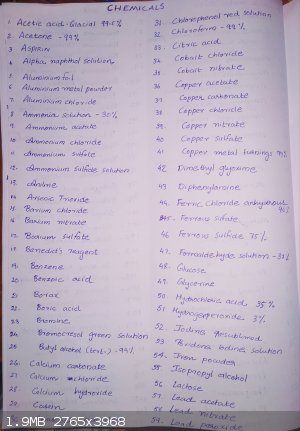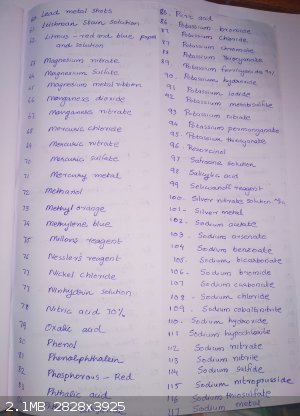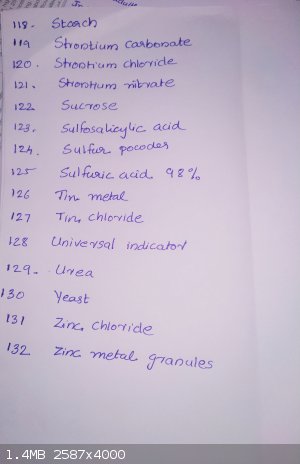vibbzlab
Hazard to Others
  
Posts: 241
Registered: 6-11-2019
Member Is Offline
Mood: Always curious
|
|
Chemical Stock list in my lab
Hello everyone
I had introduced myself as an amateur chemist few days back.
This is the list of chemicals I have in my lab which I started to collect since 7 years.
I hope I can do many videos with this stock. I just quickly noted it down. Don't know if I missed something in the hurry .
If you have ideas on demonstrations and experiments to be recorded please do mention.
Thanks in advance
  
Amateur chemist. Doctor by profession
Have a small cute home chemistry lab.

Please do check out my lab in YouTube link below
This is my YouTube channel |
|
|
Schmiddy
Harmless

Posts: 31
Registered: 6-11-2019
Member Is Offline
|
|
that's an excellent list and a good resource.
funny with all this technology in front of us I'm going to hand copy onto paper a handwritten note on a paper,LOL
I'm curious as to say the nitrates,did you make nitric acid and nitrate raw metal eg. copper wire to make copper nitrate,lead wheel weights for lead
nitrate,etc or did you obtain each one individually from a supplier?
|
|
|
vibbzlab
Hazard to Others
  
Posts: 241
Registered: 6-11-2019
Member Is Offline
Mood: Always curious
|
|
I bought nitric acid
I had lead shots from an ammunition shop. They sell lead bullets . Then I could make lead nitrate. For the copper nitrate I dipper copper in nitric
acid yea
Amateur chemist. Doctor by profession
Have a small cute home chemistry lab.

Please do check out my lab in YouTube link below
This is my YouTube channel |
|
|
fusso
International Hazard
    
Posts: 1922
Registered: 23-6-2017
Location: 4 ∥ universes ahead of you
Member Is Offline
|
|
I think chemical formula would be simpler?
|
|
|
vibbzlab
Hazard to Others
  
Posts: 241
Registered: 6-11-2019
Member Is Offline
Mood: Always curious
|
|
Well I already wrote them down 
Amateur chemist. Doctor by profession
Have a small cute home chemistry lab.

Please do check out my lab in YouTube link below
This is my YouTube channel |
|
|
woelen
Super Administrator
        
Posts: 8014
Registered: 20-8-2005
Location: Netherlands
Member Is Offline
Mood: interested
|
|
This is a nice set of chemicals. You also have a few really hard to find ones, like As2O3 and HgCl2. I myself have these as well, not from official
suppliers, but I could purchase them in a one-time chance from someone who sold chemicals from an old lab. Do you have a seller for these, or did you
make them from other materials?
|
|
|
vibbzlab
Hazard to Others
  
Posts: 241
Registered: 6-11-2019
Member Is Offline
Mood: Always curious
|
|
I have got a supplier.
I did a video on arsenic trioxide too
https://youtu.be/ZGTZHHHtCTM
Don't think there are much videos on that
Amateur chemist. Doctor by profession
Have a small cute home chemistry lab.

Please do check out my lab in YouTube link below
This is my YouTube channel |
|
|
teodor
National Hazard
   
Posts: 876
Registered: 28-6-2019
Location: Heerenveen
Member Is Offline
|
|
Quote: Originally posted by vibbzlab  | I bought nitric acid
I had lead shots from an ammunition shop. They sell lead bullets . Then I could make lead nitrate. |
Good luck with the lead nitrate.
Some hints:
1. Use a diluted nitric acid, not more than 14%, I think 7% is a good concentration to dissolve lead.
2. This stuff is very volatile, after 55C the lead nitrate forms vapours even from water solution. Don't warm/boil it without precautions
(distillation setup/outside).
3. Solid lead nitrate is also volatile, keep in well closed bottle (after several days you will see how it covers the walls of the bottle).
4. Lead usually is in a form of alloy with other elements. To purify the nitrate you can use HCl (only lead, silver and mercury chlorides are
insoluble). Pour solution of the nitrate on the bottom of a cylinder, pour 3-5 times more water by a pipette (to not mix it with a layer of the
nitrate - you will see the border between two solutions) and then pour 6M HCl by a pipette on top of the water. It will cause big clear crystals of
PbCl2 to be formed. Shake the solution gently from time to time. You will get very pure PbCl2 which you can use as a source of other lead salts. PbCl2
is also volatile (also covers the walls of a bottle).
5. For waste neutralisation use NaOH and then Na2Sx (prepared by warming 6M NaOH with sulphur). It will convert all lead to an insoluble PbS form.
[Edited on 12-11-2019 by teodor]
|
|
|
vibbzlab
Hazard to Others
  
Posts: 241
Registered: 6-11-2019
Member Is Offline
Mood: Always curious
|
|
Thanks for your information. I will take care of that
Amateur chemist. Doctor by profession
Have a small cute home chemistry lab.

Please do check out my lab in YouTube link below
This is my YouTube channel |
|
|
woelen
Super Administrator
        
Posts: 8014
Registered: 20-8-2005
Location: Netherlands
Member Is Offline
Mood: interested
|
|
Quote: Originally posted by teodor  | [...]
2. This stuff is very volatile, after 55C the lead nitrate forms vapours even from water solution. Don't warm/boil it without precautions
(distillation setup/outside).
3. Solid lead nitrate is also volatile, keep in well closed bottle (after several days you will see how it covers the walls of the bottle) [...] PbCl2
is also volatile (also covers the walls of a bottle). |
Are you sure about this volatility? I have 500 grams of dry anhydrous Pb(NO3)2, purchased from some supplier, and I never observed crystals
evaporating and then resettling on the glass walls. The same is true for my PbCl2. Both are stored at room temperature (in winter around 10 C, in
summer well over 30 C). I have both chemicals for years already.
Pb(NO3)2 is a completely ionic compound, so also from that point of view, it would really surprise me if it is volatile to such an extent that it
forms crystals on the glass walls.
I did observe this effect with quite some other chemicals (e.g. I2, PBr5, menthol, camphor, p-dichlorobenzene), but all of these are covalent
compounds.
|
|
|
Fery
International Hazard
    
Posts: 1018
Registered: 27-8-2019
Location: Czechoslovakia
Member Is Offline
|
|
My Pb(NO3)2 is also very stable, I made it more than 20 years ago - used pellets from airgun captured in target dissolved in diluted HNO3. No crystals
at wall of glass vial at all. No signs of decomposition, no change in color. Nothing. Very stable.
Tetraethyllead is volatile.
|
|
|
woelen
Super Administrator
        
Posts: 8014
Registered: 20-8-2005
Location: Netherlands
Member Is Offline
Mood: interested
|
|
I think teodor has Pb(NO3)2 with quite a lot of adhering acid. My first sample of home made Pb(NO3)2 was fuming slightly. On dissolving in water, the
solution was quite strongly acidic. After a recrystallization from distilled water, with discarding the last 10% or so, I obtained a much better
product. A few years ago, I purchased 500 grams with the intent to experiment with PbO2 anodes, but I never started that experiment, due to
environmental concerns with larger quantities of lead salts.
|
|
|
vibbzlab
Hazard to Others
  
Posts: 241
Registered: 6-11-2019
Member Is Offline
Mood: Always curious
|
|
My lead nitrate has not yet sublimed. I am not sure about it too.
Amateur chemist. Doctor by profession
Have a small cute home chemistry lab.

Please do check out my lab in YouTube link below
This is my YouTube channel |
|
|
teodor
National Hazard
   
Posts: 876
Registered: 28-6-2019
Location: Heerenveen
Member Is Offline
|
|
Yes, indeed, you are right.
Last months I was out of my hobby (I changed a job etc) and today I eventually checked what is it on the walls of the Pb(NO3)2 bottle. It was possible
to do only with help of a microscope - they are tiny droplets of liquid with refraction index quite different from water. A test paper shows they are
strongly acidic.
The information about Pb(NO3)2 volatility (but in the range 100C +) I got from Fritz Ephraim's "Inorganic chemistry". It is also connected with low
melting point of Pb, but definitely in the range 50-60C it is just evaporation of acid.
|
|
|
Bedlasky
International Hazard
    
Posts: 1239
Registered: 15-4-2019
Location: Period 5, group 6
Member Is Offline
Mood: Volatile
|
|
Nice list.
You can try blue bottle experiment. It's really nice demonstration.
Yeast on your list caught my attention. Yeast is very good catalyst for hydrogen peroxide decomposition. If you add small amount of yeast in to few
mils of 3% hydrogen peroxide, lots of bubbles are formed. This decomposition is exothermic - if you take beaker with this mixture in to your hands,
you can feel heat after some time. You can compare it with another catalysts like Fe3+ solutions, FeO(OH), CuO, MnO2 etc.
|
|
|
earpain
Hazard to Others
  
Posts: 102
Registered: 11-9-2019
Member Is Offline
|
|
I assume you did not make the P4? Is your NaOCl an (aq) solution?
Did you make the elemental Na ? How?
I might be interested in CHCl3 if it's not wildly expensive.
You're definitely missing 30% H2O2. News as of 2 weeks ago, probably has a thread on here
now....https://medschool.duke.edu/about-us/news-and-communications/med-school-blog/duke-starts-novel-decontamination-n95-masks-help-relieve-shortages
|
|
|
Bedlasky
International Hazard
    
Posts: 1239
Registered: 15-4-2019
Location: Period 5, group 6
Member Is Offline
Mood: Volatile
|
|
You can make it using haloform reaction from acetone, isopropyl alcohol or ethanol and bleach.
|
|
|